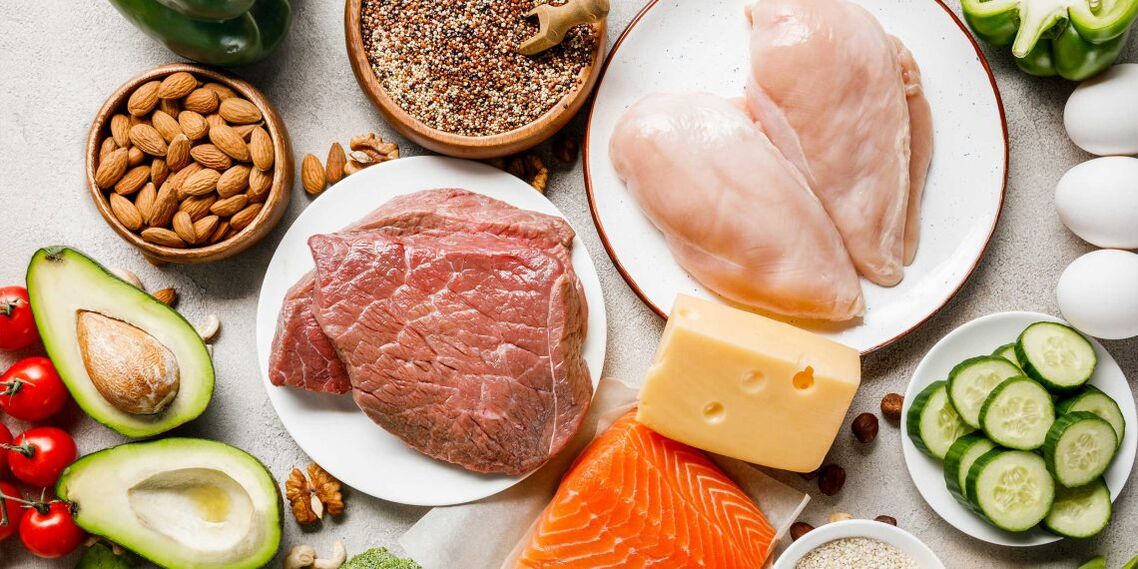On a ketogenic diet you eat a lot of fatty foods and exclude all flour and sweet. 60-70% of all calories should come from fat, 20-30% of protein and only 10% of carbohydrates. Particular attention is paid to carbohydrates: you cannot eat more than 50 g per day, regardless of the weight and consumption of calories.

Fat can be made from vegetable oils and lard, meat and fish, cheese, sour cream, ugly yogurt, eggs and nuts. Most of these products also contain enough protein to enter the daily rate - 1, 5-2 g per kilogram of body weight. You only get carbohydrates from vegetables, unsweetened fruits and fruits to gain enough vitamins. Without familiar garnishes: cereals, pasta, potatoes. An absolute ban on sweets and alcohol.
Why you lose weight on the keto diet
Carbohydrates are the main fuel of the body. When you consume less than 50 g of carbohydrates a day, their reserves in the body are exhausted after one day and the body begins to divide fat and use fatty acids to produce energy. However, not all organs can eat fat: the brain just needs glucose or some replacement.
To get glucose, the liver makes ketone bodies from fatty acids: acetate, which then becomes beta-hydroxybutic and nourishes the brain, heart, kidneys, muscles and other tissues. Acetone is formed as an exchange of a product, so its concentration in the urine increases and breathing becomes sweet.
In general, ketones are constantly produced in the body, their concentration in the blood is about 0, 2-0, 5 mmol/l. When their level grows to 0, 5-5 mmol/l, a ketosis of the food occurs. It is not dangerous to health, unlike ketoacidosis, in which the concentration of ketone bodies increases to 10-25 mmol/l. This condition can occur when starving.
Despite the fact that you do not reduce the calorie content of the diet, in the state of ketosis, the body begins to get rid of fat stores. Because blood glucose levels strive for zero, the production of the hormone insulin is inhibited and lipogenesis is the deposition of fat in a reserve. In addition, a keto diet reduces your appetite, which also helps you lose weight: you do not consider calories and do not break.
How much can you throw on a ketogenic diet
Everything is individual here. In a review of six studies dedicated to a ketogenic diet, participants lost from 3, 2 to 12 kg in six months. If we take the average for all results in the review, it will be about 6 kg in 6 months.
Who should try the keto diet
Despite the complexity of the first days and the strict restrictions, a ketogenic diet is ideal for some people. It is worth trying it:
- Those who love meat. If you cannot live without it and fatty products, and your diet is indifferent to sweets and bread, your opportunity.
- Those who want to lose weight without losing muscle mass. Keto Diet helps to eliminate fat, including visceral and at the same time preserving dry muscle mass. In addition, the diet does not affect the power indicators, so it is quite suitable for athletes of strong sports. Although it will not work to enlarge the muscles.
- People with diabetes of type 1 and 2. Due to the failures of insulin production, diabetics are forced to take this hormone to avoid sharp blood sugar jumps. Keto Diet significantly reduces its level. But before moving to keto, a diet with your doctor should be consulted.
- Those who want to maintain brain health. Keto diet has a positive effect on mental and emotional health, protects the brain from neurodegenerative diseases and helps with migraines and epilepsy.
- Those who want to reduce the risk of atherosclerosis. The diet reduces the amount of "bad" cholesterol and blood fat and increases the percentage of "good".
- Those who are afraid of the cancer keto diet limit reactive forms of oxygen and reduce inflammation, which is often associated with oncology oncology.
- Runners and athletes. If you are an athlete for a cyclic sports for endurance, a keto diet can improve your performance.

Who cannot sit on a ketogenic diet
This diet is contraindicated:
- People with kidney and liver disease, oxidation of fatty acids.
- Those who are involved in team sports, athletes, mid -distance runners. If the classes include a long stay in the anaerobic mode, the keto diet will reduce your performance.
- People with fragile bones. Possible side effects of the diet include changes in the bone mineral composition, which can lead to an increase in the risk of fractures.
Is it difficult to stick to a ketogenic diet
Keto diet is not the lightest diet, especially at the beginning. When your body begins to experience glucose, the symptoms of keto -grip may manifest: nausea, vomiting, headache, fatigue, dizziness, insomnia of constipation. They last from 2-3 days to a few weeks. In this case, you cannot consume more carbohydrates to relieve your condition.
If you break, the body will receive the desired glucose, you will come out of ketosis and you will have to repeat it again. This is the difficulty of maintaining a diet. On the other hand, this is its advantage: you know that after the breakup you will have to go through an unpleasant adaptation again, so you will hold.
How to sit on keto genetic diet
A personal trainer and nutritionist suggests dividing the period of a diet into several phases and adhere to certain rules.
1. Pre-preparation (2-4 weeks)
Enter 40-80 G coconut oil into the diet to provide your body with triglycerides with your body. They are quickly absorbed, not deposited in fat and are treated in the liver in ketone bodies. Instead of oil, you can consume a dietary supplement with ketones in the form of powder.
Reduce the amount of carbohydrates to 100 g per day. So you will not enter the ketosis, but learn that there is less food rich in carbohydrates.
2. Entry to ketosis (4 days)
Day 1. Skip breakfast and lunch, starve all day until the evening. There should be no more than 200-300 kcal, 10-15 g of protein and 15-30 g of fat at dinner. No carbohydrates.
Day 2. Eat the same serving for breakfast and for lunch, for dinner - ⅔ from your usual serving of food. No carbohydrates.
Day 3. For breakfast and lunch you can eat ⅔ from a regular serving of food, make dinner full. There are no carbohydrates yet.
Day 4. Eat your usual portions, you can include raw vegetables and unsweetened fruits.
During this phase of training it is better to replace with long walks. This will burn glucose and help to enter the ketosis faster. If you think the forces have ended on the legs, this is a good sign: glycogen reserves are almost exhausted.
Continue to take coconut oil or carbohydrate powder, add vitamins and drink with electrolytes.
3. Keto adaptation (2-4 weeks)
It will take you a few weeks to fully adapt to the diet. At this time, you should maintain carbohydrates within 30 g per day - if you are also engaged 20 g - if not. Keep in mind that in the beginning the energy level will be a little smaller. This is normal and gradually passes. At this stage, it is no longer necessary to take carbohydrate powder.

How much to sit on keto diet and how to go out so that the weight does not return
The keto genetic diet can last from 3-4 weeks to a year. There is no point in sticking to a diet for less than three weeks, because during this time your body will pass an adaptation through Keto and you will begin to get all the benefits of this diet. As for the conditions of more than a year, there is not enough scientific data to judge this, but eating like this is a bad idea. First, the prolonged keto diet increases the risk of liver obesity, hypoproteinemia, kidneys and a deficiency of vitamins and minerals. Second, the abandonment of one of the macro elements does not affect the life of life in the best way. The data analysis of more than 15, 000 people has shown that both excess and lack of carbohydrates in the long run increase the risk of death. The longest live people whose diet consisted of carbohydrates of 50-55%.
Good news: It won't be so difficult to keep weight after a diet diet.
With a conventional calorie -reducing diet, the amount of errors of errors is increased, which is why one wants to eat all the time, decay and after graduation he throws himself for food. The study showed that with ketogenic such changes did not occur, so it would be easier for you to keep weight. Another study testified that 40 days of a half -break diet for the Mediterranean diet lead to stable weight loss without further determination.
The Mediterranean diet is a great option after Keto. It also contains a lot of fats to get used to, and carbohydrates are consumed from useful sources: whole grains, vegetables and fruits. Unlike keto diet, the Mediterranean can be maintained throughout its life without health risks.















